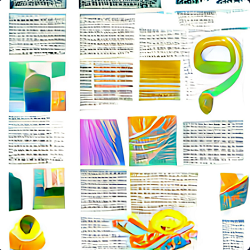
A visualization grammar is a set of rules or guidelines that describe how to create visualizations in a consistent and effective way. It defines a common vocabulary and structure for creating and interpreting visualizations, and can be used to create visualizations that are easy to understand and communicate. The grammar can include rules for things like color selection, chart types, and data encoding. A visualization grammar can be used by data analysts, designers, and other stakeholders in an organization to ensure that visualizations are created in a consistent and effective manner, and to make it easier to understand and communicate data.
Here are a few examples of visualization tools that use a visualization grammar:
-
Vega-Lite: Vega-Lite is an open-source visualization grammar and tool that is built on top of the Vega visualization grammar. It provides a higher-level, more concise language for creating visualizations, making it easy to create and share interactive visualizations with others.
-
Altair: Altair is another open-source library for creating declarative visualizations, it uses a simple and expressive syntax similar to Vega-Lite. It is built on top of the Vega-Lite visualization grammar and it is also integrated with Jupyter notebook.
-
Grammar of Graphics: Grammar of Graphics is a framework for creating visualizations, it is implemented in several languages such as R, Python and Julia. It provides a set of rules to build visualizations and it’s implemented in libraries such as ggplot2, plotnine, and others.
-
Tableau: Tableau is a commercial data visualization software that provides a drag-and-drop interface and a set of visualizations. It also uses a visualization grammar to create visualizations, allowing users to create interactive visualizations with a simple and intuitive interface.
-
Plotly: Plotly is a commercial data visualization library that provides a wide range of chart types and options for creating static and interactive visualizations. It also uses a visualization grammar to create visualizations, allowing users to create interactive visualizations with a simple and intuitive interface.
There are many data visualization tools that do not use visualization grammars, and the right tool to use will depend on the specific needs and requirements of the data, and the audience that it is intended for. Here are a few examples of data visualization tools that do not use visualization grammars:
-
Matplotlib: Matplotlib is a popular data visualization library for Python that provides a wide range of chart types and options for creating static plots and visualizations. It allows users to create visualizations with a low-level, imperative interface, allowing users to control every aspect of the visualization.
-
Seaborn: Seaborn is another data visualization library for Python, built on top of Matplotlib, it provides a higher-level, more concise interface for creating visualizations, but it still doesn't use a visualization grammar.
-
Excel: Excel is a widely used spreadsheet software that provides a wide range of chart types and options for creating static plots and visualizations. It allows users to create visualizations with a simple drag-and-drop interface, but it doesn't use a visualization grammar.
-
R base graphics: R base graphics is a package that provides a low-level, imperative interface for creating visualizations in R, it doesn't use a visualization grammar, but it can be used to create a wide range of visualizations.
-
ggvis: ggvis is a package for R that provides a similar interface to ggplot2, but it does not use a visualization grammar, it uses reactive programming to build visualizations.
Among those that don't use a visualization grammar, Matplotlib is quite popular. On the other hand, a tool that uses visualization grammar such as Vega-Lite provides a higher-level, more concise language for creating visualizations and allows to create interactive visualizations. Here are a few things that you can do with a visualization grammar that may be more difficult or less convenient to do with Matplotlib:
-
Interactive visualizations: A visualization grammar such as Vega-Lite allows you to create interactive visualizations that can be easily shared and explored by others. This can be useful for creating visualizations that can be used for data exploration and analysis, and for creating visualizations that can be embedded in web pages or Jupyter notebooks.
-
Concise and expressive visualization specification: A visualization grammar provides a more concise and expressive way to specify visualizations. Vega-Lite, for example, provides a simple, JSON-based syntax for creating visualizations, making it easy to create and share visualizations with others.
-
Layouts and Multi-View Visualization: A visualization grammar such as Vega-Lite allows you to create multi-view visualizations and layouts, you can create a dashboard with multiple charts, or you can create a visualization that can be split into multiple views and subplots, this can be useful for displaying different aspects of the data.
-
Built-in support for data transformations: A visualization grammar such as Vega-Lite provides built-in support for data transformations, including aggregations, filtering and sorting, which can be useful for data exploration and analysis.
Of course, Matplotlib can be integrated with other tools and libraries to create interactive visualizations, and it can be used to create a wide range of visualizations, but a visualization grammar such as Vega-Lite provides a higher-level, more expressive and easier way to create interactive visualizations and to work with data transformations.
Resources:
- https://www.amazon.com/Grammar-Graphics-Statistics-Computing/dp/0387245448/ref=sr_1_1?crid=1Q4WZSO82BKV6&keywords=grammar+of+graphics&qid=1674328491&sprefix=grammar+of+graphics%2Caps%2C77&sr=8-1
- https://towardsdatascience.com/a-comprehensive-guide-to-the-grammar-of-graphics-for-effective-visualization-of-multi-dimensional-1f92b4ed4149
